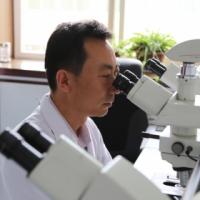| 图片: | |
|---|---|
| 名称: | |
| 描述: | |
- 女,24岁,肛门旁肿瘤(免疫组化结果已上传)

名称:图1
描述:20114931_013.jpg.jpg desmin

名称:图2
描述:20114931_014.jpg.jpg desmin 可见核旁点状阳性

名称:图3
描述:20114931_010.jpg.jpg desmin 可见核旁点状阳性

名称:图4
描述:20114931_012.jpg.jpg syn 可见核旁点状阳性

名称:图5
描述:20114931_011.jpg.jpg syn 可见核旁点状阳性
肛门旁肿瘤十余天,生长迅速,伴有疼痛。临床诊断肛门脓肿而手术。
您的诊断与鉴别诊断:1、小细胞恶性黑色素瘤。2、横纹肌肉瘤。3、小细胞(神经内分泌癌)4、滑膜肉瘤。5、PNET/EWING肉瘤。6、淋巴瘤。7、淋巴造血系肿瘤。8、其他
-
本帖最后由 学浅 于 2011-08-16 17:18:24 编辑
Base on patient's age, tumor location, HE and immunohistochemistry, this is most likely a case of rhabdomyosarcoma (perhaps alveolar subtype) based on the desmoplastic stroma. The synaptophysin immunoreactivity is difficult to explain, and I would add Cam5.2, CD56, myoD1 and/or myogenin as further immunohistochemical investigation. If Cam5.2 and CD56 are negative, and one (or both) of the two skeletal muscle markers is positive, this would rule out extraosseous Ewing sarcoma or peripheral neuroectodermal tumor and small cell carcinoma, and confirm it is rhabdomyosarcoma. I do not believe this is Merkel cell carcinoma, lymphoma or melanoma.

聞道有先後,術業有專攻
-
本帖最后由 XLJin8 于 2011-08-16 04:58:53 编辑
1)根据病人的年龄、病变部位、形态学和IHC标记结果,非常赞成诊断为:腺泡状横纹肌肉瘤。
2)对于Syn阳性的问题比较难解释,可能为1)组织处理问题,2)组织受损伤,3)IHC标记非特异性染色,4)肿瘤细胞异表达。
3)Desmin的强表达更有诊断价值。CD99-除外Ewing/PNET; 上皮性标记-可除外DSRCT;LCA-除外淋巴造血系统来源。
4)IHC增加MyoD1 或Myogenin对鉴别意义并不大。

- xljin8
-
liguoxia71 离线
- 帖子:4174
- 粉蓝豆:3122
- 经验:4677
- 注册时间:2007-04-01
- 加关注 | 发消息
Am J Surg Pathol. 2008 Jul;32(7):1022-8.
Rhabdomyosarcoma of the urinary bladder in adults: predilection for alveolar morphology with anaplasia and significant morphologic overlap with small cell carcinoma.
Rhabdomyosarcoma (RMS) represents the most common malignant soft tissue tumor in children and adolescents with the urinary bladder representing a frequent site. Most of these urinary bladder tumors are embryonal RMS, predominantly the botryoid subtype. RMSs of the urinary bladder in adults are distinctively rare and the subject of only case reports. We report the clinicopathologic features of 5 bladder neoplasms with rhabdomyosarcomatous differentiation in adults and emphasize the differential diagnosis in the adult setting. The patients, 4 men and 1 woman, ranged in age from 23 to 85 years (mean 65.4 y). Gross hematuria was the most common initial symptom, although 2 patients had metastatic disease at presentation. Four cases were pure primary RMSs of the bladder and 1 case was a sarcomatoid urothelial carcinoma with RMS representing the extensive heterologous component. All 5 cases demonstrated a diffuse growth pattern (ie, non-nested), of which 4 cases had nuclear anaplasia (Wilms criteria without the atypical mitotic figure requirement); only 1 case (the sarcomatoid carcinoma) showed obvious rhabdomyoblastic differentiation (ie, strap cells). Three cases were of the alveolar subtype (1 admixed with embryonal histology) and 2 were RMS, not further classified. Microscopically, all tumors had a primitive undifferentiated morphology with cells containing scant cytoplasm, varying round to fusiform nuclei with even chromatin distribution, and frequent mitoses. The degree of morphologic overlap with small cell carcinoma of the bladder, a relatively more common round cell tumor in adults, was striking. The epithelial component of the sarcomatoid carcinoma was high-grade invasive urothelial carcinoma with glandular differentiation. No other case had previous history of bladder cancer or concurrent carcinoma in situ or invasive urothelial carcinoma. All tumors showed immunohistochemical expression for desmin, myogenin, and/or MyoD1. Synaptophysin was performed in 4 cases, and 3 showed weak cytoplasmic immunoreactivity. Two patients received chemotherapy, 2 underwent cystectomy, and 1 had transurethral resection alone. Outcome data were available in 4 cases, and all 4 died of disease (1, 4, 8, and 8 mo). In conclusion, (1) RMS of the urinary bladder in adults more commonly presents as a primitive round blue cell neoplasm that has significant morphologic and immunohistochemical overlap with small cell carcinoma of the bladder. (2) Although RMS in children generally have a botryoid embryonal histology with favorable outcome, bladder RMS in adults frequently demonstrates alveolar or unclassified histology, commonly with anaplasia, and have a uniformly aggressive clinical course.

- 王军臣
在头颈部,有的腺泡状横纹肌肉瘤也可表达Syn。那么,本例肛门发生的腺泡状横纹肌肉瘤表达Syn就不足为怪。
Alveolar rhabdomyosarcoma of the head and neck region in older adults: genetic characterization and a review of the literature.
Alveolar rhabdomyosarcoma is remarkably rare in adults older than 45 years. Initial immunoprofiling of a small cell neoplasm of the head and neck region in an older adult may not include myogenic markers. A valuable diagnostic aid and important prognostic parameter in alveolar rhabdomyosarcoma is the identification of PAX3-FOXO1 [t(2;13)(q35;q14)] or PAX7-FOXO1 [t(1;13)(p36;q14)] rearrangements. The purpose of this study was to document the clinicopathologic, immunophenotypic, and genetic features of head/neck alveolar rhabdomyosarcoma in older adults. Prior isolated descriptions of 3 patients were included. Five patients were female and 2 male (median age, 61 years). Each neoplasm was composed of undifferentiated, small round cells in a predominantly solid pattern. Initially, ordered immunostains corresponded with early diagnostic impressions of a hematologic malignancy or neuroendocrine carcinoma. CD56 was positive in 5 of 5 tumors and synaptophysin in 1 of 6. Given the virtual absence of other lymphoid or epithelial markers, muscle immunostains were performed and these were positive. Definitive alveolar rhabdomyosarcoma diagnoses were confirmed genetically. This study illustrates the diagnosis of head/neck alveolar rhabdomyosarcoma in older adults is complicated by its rarity, lack of an alveolar pattern, and a potentially misleading immunoprofile (CD56 and synaptophysin immunoreactivity) if myogenic markers are not used. Both PAX3- and PAX7-FOXO1 alveolar rhabdomyosarcomas were identified in these patients. In children, PAX7-FOXO1 alveolar rhabdomyosarcoma is associated with a significantly longer event-free survival. In contrast, adult alveolar rhabdomyosarcoma behaves more aggressively with a worse overall survival than pediatric alveolar rhabdomyosarcoma. Further follow-up and additional cases are required to assess the prognostic relevance of these fusion transcripts in the context of advanced age.

- 王军臣
Base on patient's age, tumor location, HE and immunohistochemistry, this is most likely a case of rhabdomyosarcoma (perhaps alveolar subtype) based on the desmoplastic stroma. The synaptophysin immunoreactivity is difficult to explain, and I would add Cam5.2, CD56, myoD1 and/or myogenin as further immunohistochemical investigation. If Cam5.2 and CD56 are negative, and one (or both) of the two skeletal muscle markers is positive, this would rule out extraosseous Ewing sarcoma or peripheral neuroectodermal tumor and small cell carcinoma, and confirm it is rhabdomyosarcoma. I do not believe this is Merkel cell carcinoma, lymphoma or melanoma.
马老师发言:
本例鉴于患者年龄、肿瘤发生的部位、HE形态和免疫组化标记,有促纤维增生性间质,很可能是横纹肌肉瘤(腺泡型可能)。Syn阳性难以解释。建议增加CAM5.2、CD56、myoD1和/或myogenin,以作进一步免疫组化探讨。要是CAM5.2和CD56阴性,而上述两个骨骼肌标记有1个(或两个)阳性,将除外骨外尤文氏肉瘤或PNET以及小细胞癌,可证明本例是横纹肌肉瘤。本人不认为该例是Merkel 细胞癌、淋巴瘤或黑色素瘤。

- 王军臣
Base on patient's age, tumor location, HE and immunohistochemistry, this is most likely a case of rhabdomyosarcoma (perhaps alveolar subtype) based on the desmoplastic stroma. The synaptophysin immunoreactivity is difficult to explain, and I would add Cam5.2, CD56, myoD1 and/or myogenin as further immunohistochemical investigation. If Cam5.2 and CD56 are negative, and one (or both) of the two skeletal muscle markers is positive, this would rule out extraosseous Ewing sarcoma or peripheral neuroectodermal tumor and small cell carcinoma, and confirm it is rhabdomyosarcoma. I do not believe this is Merkel cell carcinoma, lymphoma or melanoma.
马老师发言:
本例鉴于患者年龄、肿瘤发生的部位、HE形态和免疫组化标记,有促纤维增生性间质,很可能是横纹肌肉瘤(腺泡型可能)。Syn阳性难以解释。建议增加CAM5.2、CD56、myoD1和/或myogenin,以作进一步免疫组化探讨。要是CAM5.2和CD56阴性,而上述两个骨骼肌标记有1个(或两个)阳性,将除外骨外尤文氏肉瘤或PNET以及小细胞癌,可证明本例是横纹肌肉瘤。本人不认为该例是Merkel 细胞癌、淋巴瘤或黑色素瘤。

- 王军臣
Base on patient's age, tumor location, HE and immunohistochemistry, this is most likely a case of rhabdomyosarcoma (perhaps alveolar subtype) based on the desmoplastic stroma. The synaptophysin immunoreactivity is difficult to explain, and I would add Cam5.2, CD56, myoD1 and/or myogenin as further immunohistochemical investigation. If Cam5.2 and CD56 are negative, and one (or both) of the two skeletal muscle markers is positive, this would rule out extraosseous Ewing sarcoma or peripheral neuroectodermal tumor and small cell carcinoma, and confirm it is rhabdomyosarcoma. I do not believe this is Merkel cell carcinoma, lymphoma or melanoma.
马老师发言:
本例鉴于患者年龄、肿瘤发生的部位、HE形态和免疫组化标记,有促纤维增生性间质,很可能是横纹肌肉瘤(腺泡型可能)。Syn阳性难以解释。建议增加CAM5.2、CD56、myoD1和/或myogenin,以作进一步免疫组化探讨。要是CAM5.2和CD56阴性,而上述两个骨骼肌标记有1个(或两个)阳性,将除外骨外尤文氏肉瘤或PNET以及小细胞癌,可证明本例是横纹肌肉瘤。本人不认为该例是Merkel 细胞癌、淋巴瘤或黑色素瘤。

- 王军臣
Base on patient's age, tumor location, HE and immunohistochemistry, this is most likely a case of rhabdomyosarcoma (perhaps alveolar subtype) based on the desmoplastic stroma. The synaptophysin immunoreactivity is difficult to explain, and I would add Cam5.2, CD56, myoD1 and/or myogenin as further immunohistochemical investigation. If Cam5.2 and CD56 are negative, and one (or both) of the two skeletal muscle markers is positive, this would rule out extraosseous Ewing sarcoma or peripheral neuroectodermal tumor and small cell carcinoma, and confirm it is rhabdomyosarcoma. I do not believe this is Merkel cell carcinoma, lymphoma or melanoma.
马老师发言:
本例鉴于患者年龄、肿瘤发生的部位、HE形态和免疫组化标记,有促纤维增生性间质,很可能是横纹肌肉瘤(腺泡型可能)。Syn阳性难以解释。建议增加CAM5.2、CD56、myoD1和/或myogenin,以作进一步免疫组化探讨。要是CAM5.2和CD56阴性,而上述两个骨骼肌标记有1个(或两个)阳性,将除外骨外尤文氏肉瘤或PNET以及小细胞癌,可证明本例是横纹肌肉瘤。本人不认为该例是Merkel 细胞癌、淋巴瘤或黑色素瘤。

- 王军臣
Am J Surg Pathol. 2008 Jul;32(7):1022-8.
Rhabdomyosarcoma of the urinary bladder in adults: predilection for alveolar morphology with anaplasia and significant morphologic overlap with small cell carcinoma.
Rhabdomyosarcoma (RMS) represents the most common malignant soft tissue tumor in children and adolescents with the urinary bladder representing a frequent site. Most of these urinary bladder tumors are embryonal RMS, predominantly the botryoid subtype. RMSs of the urinary bladder in adults are distinctively rare and the subject of only case reports. We report the clinicopathologic features of 5 bladder neoplasms with rhabdomyosarcomatous differentiation in adults and emphasize the differential diagnosis in the adult setting. The patients, 4 men and 1 woman, ranged in age from 23 to 85 years (mean 65.4 y). Gross hematuria was the most common initial symptom, although 2 patients had metastatic disease at presentation. Four cases were pure primary RMSs of the bladder and 1 case was a sarcomatoid urothelial carcinoma with RMS representing the extensive heterologous component. All 5 cases demonstrated a diffuse growth pattern (ie, non-nested), of which 4 cases had nuclear anaplasia (Wilms criteria without the atypical mitotic figure requirement); only 1 case (the sarcomatoid carcinoma) showed obvious rhabdomyoblastic differentiation (ie, strap cells). Three cases were of the alveolar subtype (1 admixed with embryonal histology) and 2 were RMS, not further classified. Microscopically, all tumors had a primitive undifferentiated morphology with cells containing scant cytoplasm, varying round to fusiform nuclei with even chromatin distribution, and frequent mitoses. The degree of morphologic overlap with small cell carcinoma of the bladder, a relatively more common round cell tumor in adults, was striking. The epithelial component of the sarcomatoid carcinoma was high-grade invasive urothelial carcinoma with glandular differentiation. No other case had previous history of bladder cancer or concurrent carcinoma in situ or invasive urothelial carcinoma. All tumors showed immunohistochemical expression for desmin, myogenin, and/or MyoD1. Synaptophysin was performed in 4 cases, and 3 showed weak cytoplasmic immunoreactivity. Two patients received chemotherapy, 2 underwent cystectomy, and 1 had transurethral resection alone. Outcome data were available in 4 cases, and all 4 died of disease (1, 4, 8, and 8 mo). In conclusion, (1) RMS of the urinary bladder in adults more commonly presents as a primitive round blue cell neoplasm that has significant morphologic and immunohistochemical overlap with small cell carcinoma of the bladder. (2) Although RMS in children generally have a botryoid embryonal histology with favorable outcome, bladder RMS in adults frequently demonstrates alveolar or unclassified histology, commonly with anaplasia, and have a uniformly aggressive clinical course.
文中Syn为弱阳性,而此例是明显的阳性,另一篇文献中没有提到其阳性强度如何,一般而言,Syn的特异性还是不错的,至少不比desmin差吧。对于这样的病例,传统的病理学辅助手段很难再有说服力,可能只能靠遗传学及超微病理检查了。

- The More We See, The Less We Know!
































